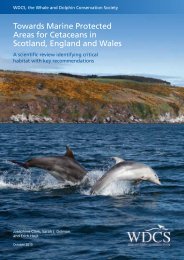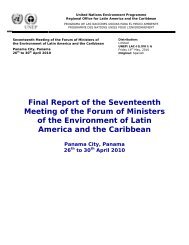Sea Turtle Recovery Action Plan for Barbados - WIDECAST
Sea Turtle Recovery Action Plan for Barbados - WIDECAST
Sea Turtle Recovery Action Plan for Barbados - WIDECAST
You also want an ePaper? Increase the reach of your titles
YUMPU automatically turns print PDFs into web optimized ePapers that Google loves.
CEP Technical Report No. 12<br />
may be harder to catch because they are not approaching and departing from nesting beaches, nor<br />
are they mating at the water's surface. Thus, during the season when pelagic fish such as flying<br />
fish (Hirundichthys affinis) and dolphin fish (Coryphaena hippurus) become abundant, fishermen<br />
concentrate on this more profitable fishery rather than on sea turtles.<br />
Very few fishermen, if any, are dependent on the turtle fishery <strong>for</strong> their primary<br />
livelihood. No reliable records of turtle landings at fish markets have ever been kept, again<br />
suggesting that the turtle fishery was never considered important. At the present time, the<br />
majority of turtles are probably captured illegally whilst laying eggs on the beach. Certainly a<br />
high proportion of hawksbills observed nesting by the public is killed annually (15-22%, section<br />
2.4). Consistent with a lack of economic dependence of Barbadians on sea turtles, there is a<br />
general lack of superstitions or traditions associated with sea turtles when compared to other<br />
islands in the region. This lack of dependence, combined with the high literacy rate in <strong>Barbados</strong>,<br />
may make conservation of sea turtles in <strong>Barbados</strong> relatively easier than in some other parts of the<br />
region.<br />
II. STATUS AND DISTRIBUTION OF SEA TURTLES IN BARBADOS<br />
2.1 Caretta caretta, Loggerhead <strong>Sea</strong> <strong>Turtle</strong><br />
There are no indigenous common names applied to this species and the preferred name is<br />
loggerhead. The loggerhead turtle is recognized by its large head, thick, somewhat tapered<br />
carapace (=shell), brown and gold or reddish-brown colouration, and characteristically heavy<br />
encrustation of invertebrate epifauna (especially barnacles). There are typically five pairs of<br />
lateral scutes on the carapace (Figure 1). The large head and strong jaws, <strong>for</strong> which the species<br />
was named, are necessary adaptations to a diet of mollusks and hard-shelled crabs; tunicates,<br />
fishes, and plants are also eaten (Dodd, 1988). Adults attain a straight-line carapace length of<br />
120 cm (nuchal notch to posterior tip) and weigh up to 200 kg (Pritchard et al., 1983).<br />
The species has a wide oceanic distribution. In the Atlantic Ocean individuals have been<br />
sighted as far north as Newfoundland (Squires, 1954) and northern Europe (Brongersma, 1972)<br />
and as far south as Argentina (Frazier, 1984). Nesting grounds are often located in temperate<br />
latitudes, with the greatest numbers of nesting females recorded on the Atlantic coast of Florida<br />
(USA) and on the shores of Masirah Island, Oman. Nesting is also reported from various islands<br />
of the Greater and Lesser Antilles (although firm records are not always available), the<br />
Caribbean coasts of Mexico and Central America, and the Atlantic coast of South America from<br />
Venezuela to Brazil, as summarized by Dodd (1988).<br />
Loggerheads are not known to nest in <strong>Barbados</strong>, but juveniles (one weighed 32 kg) and<br />
adults or near-adults (one measured 83 cm straight carapace length) are occasionally caught<br />
opportunistically offshore by pelagic fishermen. These turtles are usually speared by the<br />
fishermen as they wait <strong>for</strong> their gill nets to fill (see section I). The meat is eaten whenever<br />
available. Foraging grounds have not been identified. Neither spatial nor temporal patterns of<br />
distribution are known. Population estimates are not available. The species is considerably rarer<br />
than either the green turtle or the hawksbill.<br />
Page 2

















